Samsung Galaxy Note Pro 12.2-inch specs and price in Kenya, Samsung Galaxy Note Pro 12.2-inch price in Kenya, Samsung Galaxy Note Pro 12.2-inch price in Kenya, Samsung Galaxy Note Pro 12.2-inch Price in Kenya Safaricom, Samsung Galaxy Note Pro 12.2-inch price in Kenya, Samsung Galaxy Note Pro 12.2-inch price in Kenya, Samsung Galaxy Note Pro 12.2-inch price in Kenya, Samsung Galaxy Note Pro 12.2-inch price in Kenya, Samsung Galaxy Note Pro 12.2-inch price in Kenya, Samsung Galaxy Note Pro 12.2-inch Price in Kenya, Samsung Galaxy Note Pro 12.2-inch Price in Kenya,
This review is written by Amy Lewark.
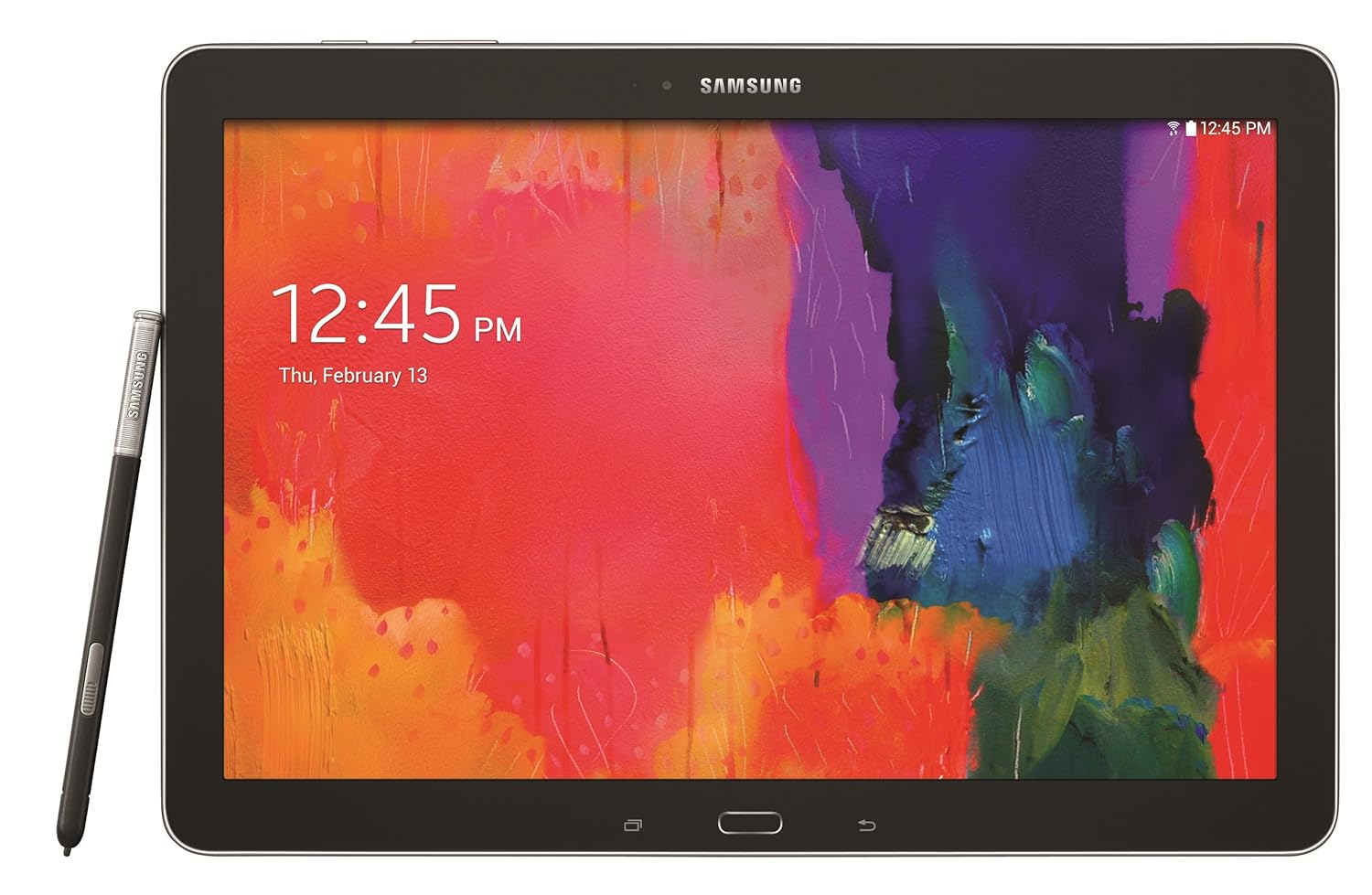
My name is Amy Lewark and I have been using a Samsung Galaxy Note Pro 12.2 for sketching and art since February 2015.
Once I started experimenting with this tablet to make art, I enjoyed it
so much I became addicted. I used it for weeks straight, foregoing all
other media (despite recently completing an exciting remodel of my
studio).
This tablet is a drastic leap forward over any digital platform for creating art I used in the past. Before I had this Android tablet, I had an iPad 2, but I did not use it regularly for artistic pursuits as I found the lack of a pressure-sensitive stylus frustrating.
I am classically-trained with traditional media and so I appreciate effective digital mimicry of a real-life artistic experience.
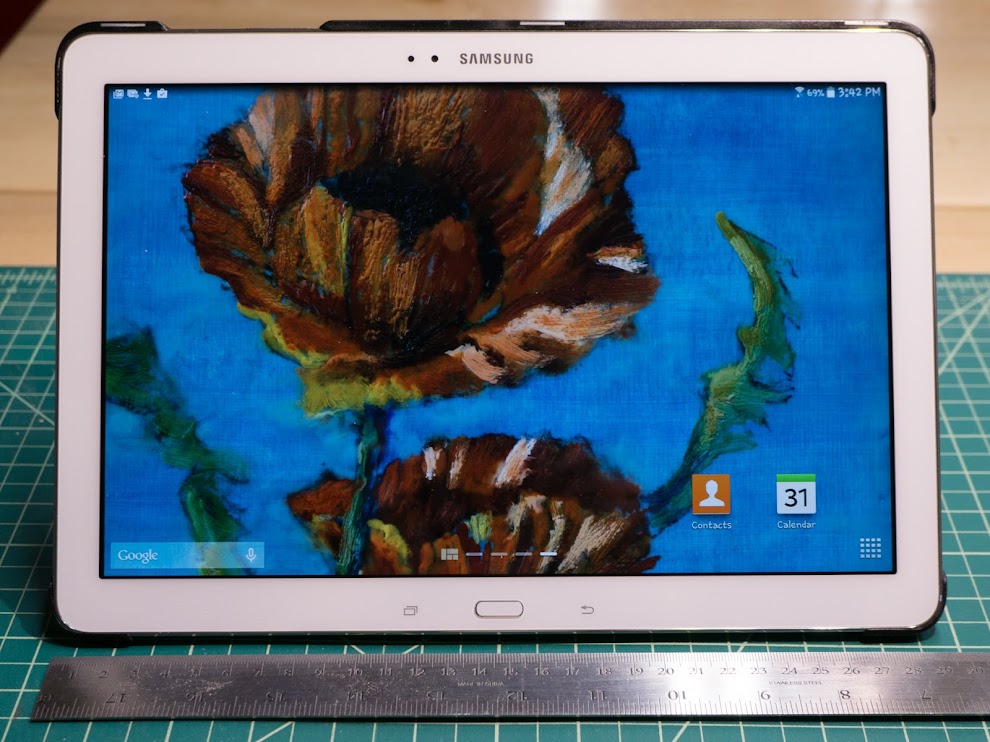
Samsung Galaxy Note Pro 12.2” Display
In April 2014 when I acquired the Samsung Galaxy Note Pro 12.2, I had originally wanted to get an iPad Air as an upgrade of my iPad 2. When I went to get the upgrade at the store, I decided to look at the Samsung and other tablets available before finalizing my iPad purchase.
I discovered that for about the same price as the iPad Air 64GB, I could get a 12.2” screen and a pressure-sensitive stylus from Samsung. As an artist, the decision was easy.
I have been using Android phones since the original release of the Motorola Droid in 2009, and hacked my Barnes and Noble Nook Color to Android in 2011, so I have watched the development of the Android OS and felt comfortable buying an Android tablet.
This Samsung tablet was released with the super-smooth Android KitKat 4.4.2 OS with Magazine UX.
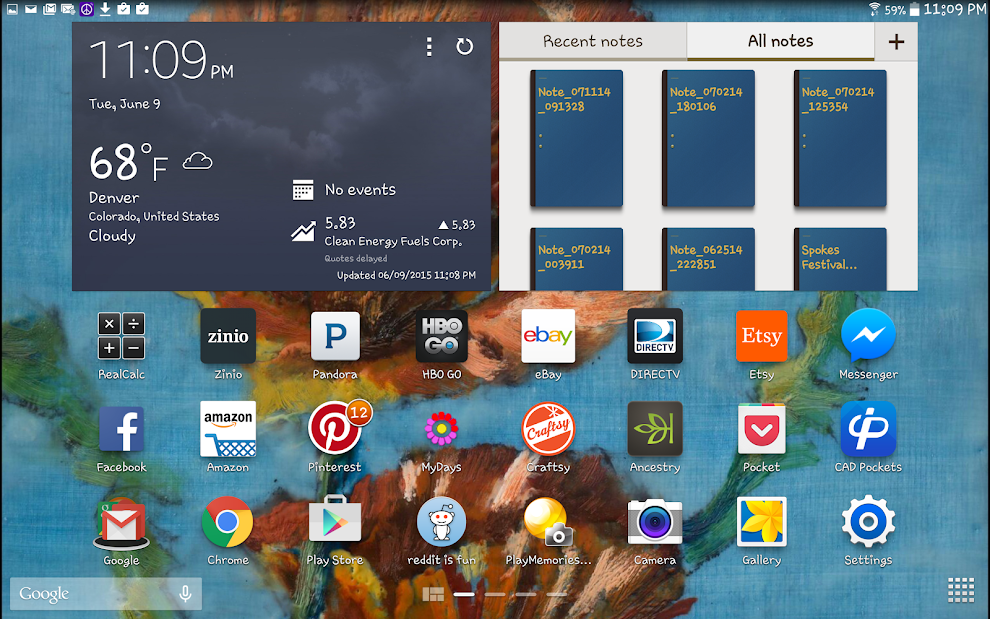 Main screen: Main Screen: Android KitKat OS
Main screen: Main Screen: Android KitKat OS
My Samsung Galaxy S4 phone was recently updated with Android Lollipop, and I am looking forward to when that update gets pushed to Samsung Galaxy Note Pro 12.2 users outside of Europe.
 Customizable Customizable Magazine UX
Customizable Customizable Magazine UX
Aside from the aforementioned extra 2.5 inches of screen and pressure-sensitive stylus, the Samsung Galaxy Note Pro 12.2 also has a 1.9 GHz Exynos(R) 5 Octacore Processor, 3GB Internal RAM, and a microSD capacity up to 64GB, bringing the total potential storage up to 96GB and enabling multiple windows multitasking.
For a mobile device that is not a full-fledged computer, this tablet is very powerful.
It weighs 753g (1.66 lbs).

 MicroSD and USB 3.0 ports on the right-hand side of the tablet
MicroSD and USB 3.0 ports on the right-hand side of the tablet
The battery is purported to last 13 hours for typical internet use, and that has been my finding as well. If I am doing typical intermittent reading or watching videos, the device lasts all day (two days, even). If I am in a 3 hour drawing session, I make sure to charge the device in advance, and turn off the screen during any breaks I take.
The tablet easily lasts three hours in drawing mode, and only once have I gotten the low battery warning when I neglected to charge it before my evening drawing session. Charging is accomplished using a standard USB 3.0 power cable, so if for some reason the cable gets lost, it is cheap and easy to replace.
The S-Pen is short and thin, and has no battery. How it works is pretty interesting, especially since it is not powered in the traditional sense with a battery, yet it is still pressure-sensitive.
The S-Pen has 1024 levels of sensitivity thanks to a Wacom digitizer built into the tablet. There are ways to hack the pressure sensitivity using two tiny potentiometers under the button if one is feeling adventurous.
 11.5 cm Samsung S-Pen stylus
11.5 cm Samsung S-Pen stylus
I suppose the S-PEN might be easy to lose due to its size, but the tablet itself has a built-in storage compartment on the upper right side, and sound feedback when removing or replacing the S-Pen lets the user know when the pen is successfully stowed and removed.
In the event the stylus does become lost, inexpensive replacements can be found easily online. Originally, I was worried about hand cramping while using this stylus due to its svelte characteristics; however, I have found that holding it lightly far from the tip yields more pleasing results with my art.
For anyone who can’t manage the tiny profile of the S-Pen, Wacom has released the Bamboo Stylus feel for Samsung Galaxy Note for $39.99USD. At that price, I think I would be more nervous about losing the Wacom stylus!
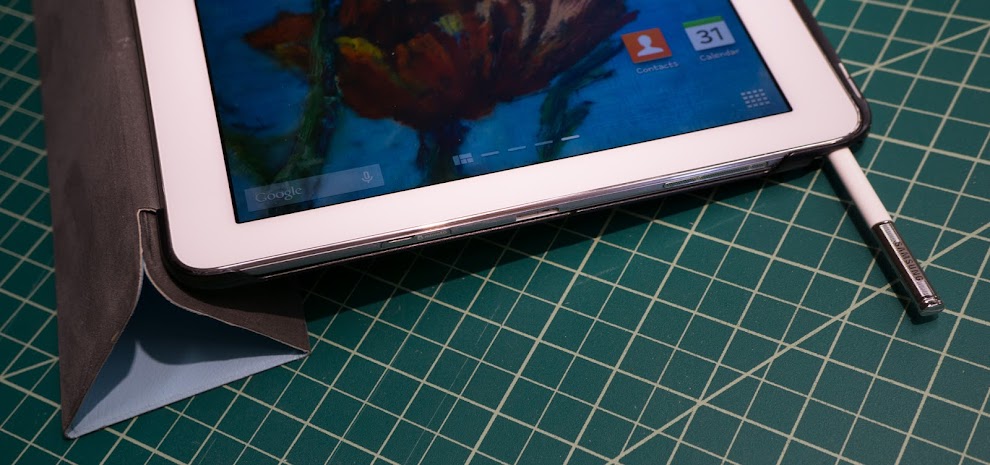 S-Pen storage compartment at right-hand top corner
S-Pen storage compartment at right-hand top corner
The contents of the box at purchase were just the tablet, S-Pen and USB power cord with plug.
The tablet is sleek, with very little texture, so I purchased a minimalist aftermarket case/stand for mine from Fintie on Amazon to give it more substance, protect the screen, and also angle it for more comfortable use.
This case has proven to be a wise purchase now that my tablet is a staple in my artwork. I purchased another case with bluetooth keyboard so that I will be able to blog and email while traveling.
The Samsung Galaxy Note Pro 12.2 has proven its usefulness to me as a fine artist. Initially, the way the S-Pen glides over the slick screen was strange; it felt fast and uncontrollable.
However, as I said before, holding the stylus back 5-6 cm helped tremendously, getting me to loosen up and capitalize on the slipperiness. Sometimes I hold the S-Pen with an overhand grip, but generally I make use of the trick to draw from the arm and shoulder rather than the wrist as much as possible.
I take the tablet each week to short (3 hour) portrait drawing sessions, so I work in a fresh, quick style. I have taken it once plein air painting, but working with it outdoors has proved challenging with the bright sun.
I often use it to display reference photos for my studio work, and I love the resulting luminous quality I get in my painting. Unlike when I use my laptop, it’s easy to prop my tablet up on the easel in either portrait or landscape orientation next to my painting for quick comparison.
Furthermore, using the 50GB Dropbox account which is included with the purchase of the Samsung Galaxy Note Pro 12.2, it is easy to share files across my various devices.
I can send photos via wireless to my Samsung Tablet easily from my Sony a6000 mirrorless interchangeable lens digital camera and edit them using Photoshop Touch before sharing them on social media. This tablet has become an indispensable tool in my creative life.
Although I initially made my purchase of the tablet with artistic intentions, it had only been released two months prior, so it was some time before satisfactory applications were available for making serious art.
In 2015, there are several applications available through the Google Play Store which enable users to do sketching and airbrushing, and a few more which serve to duplicate an artist’s studio fairly effectively. The offerings are summarized in the table below:
| Model |
Art Flow |
Art Rage |
Autodesk Sketchbook |
Autodesk Sketchbook Express |
Infinite Painter |
Corel Painter Mobile |
| Price |
Free (Pro $2.99USD) |
A$4.99USD |
$3.99USD |
Free |
Free (Trial) |
Free (Pro $4.99) |
| In App Purchases |
No |
No |
No |
No |
Yes |
No |
| Max resolution |
4096x4096 |
2048x2048 |
2826x2830 |
1280x800 |
2048x2048 |
1024x1024, 2048x2048 (Pro) |
| File formats |
JPG, PNG & PSD |
JPG, PNG |
PSD, PNG (Preview) |
JPG, PNG |
JPG, PNG & PSD |
JPG, PNG & PSD (Pro) |
| Layers |
7 to 16, depending on size |
Infinite |
3 at Max Resolution |
3 |
15 |
15 |
| Real World Art Tools* |
No |
Yes |
No |
No |
No |
Yes |
| Pressure Sensitivity for Ink/Graphite |
Good/Good |
Good/Good |
None/None |
None/None |
Excellent/Excellent |
Good/Good |
| Undo/Redo | Unlimited (Pro) | Unlimited | 10 | 10 | Unlimited | Unlimited/19 |
*Includes painting media such as oil and watercolor (not just airbrush or fancy marker effects) and chalk or pastel effects
ArtFlow
ArtFlow is relatively inexpensive, and allows for a 4096x4096 composition. I found the interface a little obtuse at first. When the program was first launched, a blank screen appears and there are two tiny arrows in the center of the left and right sides which bring the layer and file (left) and tool (right) controls into view.
his allows for a completely clear workspace when one is drawing or painting. Once one starts painting, the controls disappear. The tool controls are very easy to understand, unlike the layer and file controls. Having to bring out the tool controls regularly just to hit undo is a tad annoying.
Under the quill pen, as expected, are the ink pen tools. It’s possible to change the size, flow, opacity and softness of each pen type, and also the spacing between the pixels which compose the line.
In addition, there are two toggle switches for “Size dynamics” and “Flow dynamics” which seem to control how the pen line responds to the pressure used on the stylus. Turning off either of these controls makes the program ignore the stylus pressure with respect to the size or the flow of the line, respectively.
Under the pencil tool, there are pencils all the way from H2 (Hard) to B4 (Soft). It is possible to control the opacity and size dynamics of the pencils, but nothing else. There is a smudge tool one could use to blend pencil or ink lines, but generally, I believe it will be difficult to make anything resembling a real-world pencil sketch using the side of the pencil for shading.
As you can see, both the pen and the pencil respond decently to varying the pressure on the stylus. The pencil isn’t a convincing pencil when set to black; however it becomes a little more so when set to a gray color. For this test I used an HB pencil simulation.
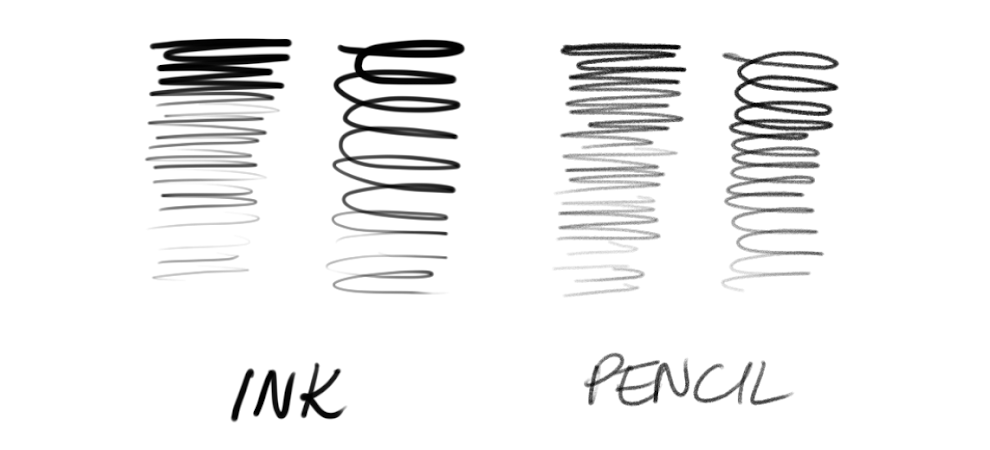
ArtFlow: Ink and Pencil Stylus Pressure tests
Saving is not as straightforward as I would like; it is accomplished either by hitting the share vertex icon or the grid of six rectangles (indicating a gallery), in the controls on the left side of the screen.
On this same control panel, there is a square that looks like it has a mallet or a scraper or… ? (I still can’t figure out what that is supposed to be). Click that and you lose all your work. ;)
ArtFlow has many of the standard Photoshop layer controls and filters, and also some attempts at oil paint and pastel media, but many of the tools are not available in the free version.
ArtRage
ArtRage is a program I have been using semi-regularly since February 2015. It has become my go-to program for making art on the tablet and the computer. As a traditional artist, it is the closest thing I have found to a mobile art studio.
I actually started using it because sometimes when I am running out of the house to go drawing or painting, I don’t have my supplies together, or I am tired but still want to go just for the therapeutic value of making art, and if all I have to do is grab my tablet, I’m more likely to actually go.
Furthermore, in a crowded studio, I can find a nice spot on the floor to view the subject (though I often put my tablet up on an easel). It makes art so approachable. The controls are simple and intuitive, and don’t require much time to learn.
If I was going to nit-pick, in a perfect world, the two improvements I would make to ArtRage are that 1) I would like the watercolor to behave more like watercolor (make it flow into wet spaces and respond to gravity, rather than have it behave like transparent oil or acrylic) and 2) I would like a chalk pastel rather than an oil/wax crayon type of pastel. I know the physics of the first one would be pretty difficult, but hey, it never hurts to ask, right?
Since this review is about sketching and drawing, here is the performance of the ink pen and pencil from ArtRage. Doing an apples-to-apples comparison on this software is challenging because from the get-go I had to choose the paper (so I chose soft, white paper).
The papers have textures which affect the behavior of the media chosen. In any case, you can see the results are different. The pressure sensitivity did seem less gradated in ArtRage on both the ink and the pencil than in ArtFlow. Getting the lightest values to show up felt more difficult.
Also, the pen wanted to skip when I would lessen the pressure. I do think the pencil is a more convincing pencil. There are, of course, several different types of pencil, so for this test I chose “Hard and Dark.”

ArtRage: Ink and Pencil Stylus Pressure tests
Autodesk Sketchbook
Autodesk Sketchbook is one of the first apps that was available for use on the Samsung Galaxy Note Pro 12.2. It is simple and easy to use and provides a limited range of tools like pencil, mechanical pencil, ink pen, brush, marker and airbrush.
I did some sketches using this software in February before I discovered ArtRage.

Autodesk Sketchbook: Ink and Pencil Stylus Pressure tests
The advanced tools (including pencils of varying hardness) were difficult to locate. There is yet another menu that pops up when the greyed out art tool icon is clicked.
Autodesk Sketchbook Express
Autodesk Sketchbook Express is the software that comes pre-installed on the Samsung Galaxy Note Pro 12.2. It is essentially a stripped-down version of Autodesk Sketchbook, and half the resolution. The results of the stylus pressure test are similar, though the pencil is less blurry/smudgy.
As you can see below, the ink pen does not allow for pressure sensitive variation in the line; it is more like a Micron pen than a quill. The pencil (I chose HB and had to make it wider as the default is almost hair-thin) does not have sufficient pressure-sensitive variation in the line, either.
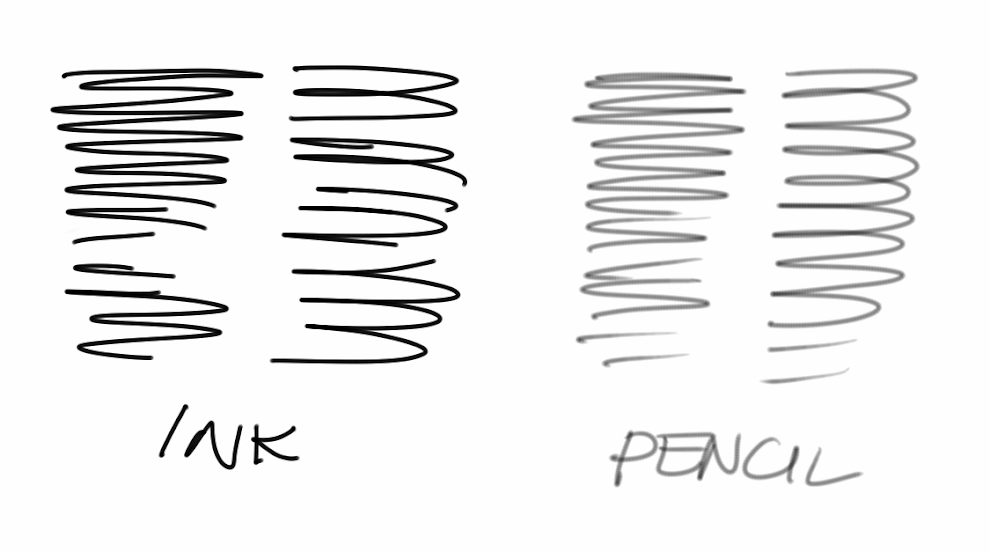
Autodesk Sketchbook Express: Ink and Pencil Stylus Pressure tests
Infinite Painter is one of the first apps I downloaded after I got my Samsung Galaxy Note Pro 12.2 Tablet. I made it through most of a painting of a Columbine flower and the software crashed causing me to lose all my work.
Quite a few of the reviews on Google Play said it was great software, but would crash and work would be lost. Over a year later, just trying to write this review, the application unexpectedly closed twice!

Infinite Painter: Ink and Pencil Stylus Pressure tests
Corel Painter Mobile
Corel Painter Mobile is the final application I have tested for this review. This app is new to me, so I am not fully aware of all of its capabilities. Like Infinite Painter, there were numerous choices for Ink Pens, with differing characteristics.
I chose the Ballpoint Pen for this test, because the fountain pen did not exhibit pressure-sensitivity. For the pencil, I chose HB, and while it does become thinner and lighter as the pressure on the stylus is lessened, I don’t feel like it resembles an actual pencil.

Corel Painter Mobile: Ink and Pencil Stylus Pressure tests
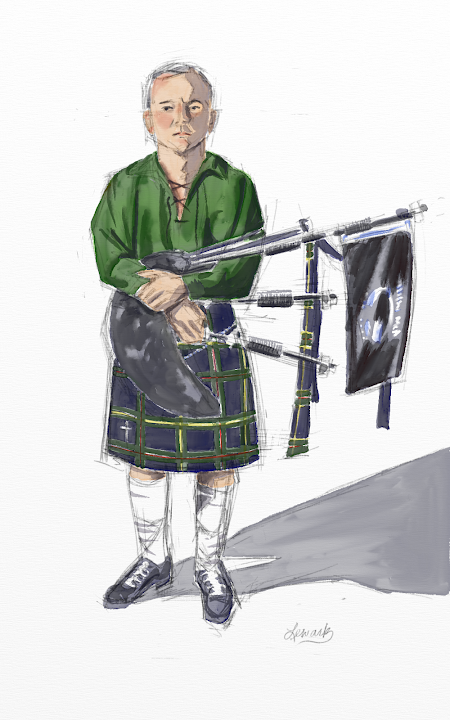
The Scotsman, digital pencil and watercolor on ArtRage using Samsung Galaxy Note Pro 12.2
The characteristics of all these Ink and Pencil samples are so different, I am not able to say if I have a preference for one over another.
If you’re wanting to take the best advantage of the pressure-sensitive S-Pen for drawing and sketching, any app except the Autodesk products will allow that on the Samsung Galaxy Note Pro 12.2.
Depending on the style you wish to achieve, you might prefer the sharper qualities of ArtFlow and ArtRage’s pencils, or the softer nature of Infinite Painter or Corel Painter Mobile’s pencils for shaded effects.
The expressive qualities of the different ink options on Infinite Painter could yield some alluring results, if the bugs could be worked out of that program.
Conclusion
In summary, here is a list of the Pros and Cons of the Samsung Galaxy Note Pro 12.2:
Pros:
- Accuracy and pressure sensitivity of S-Pen is close enough to the real thing
- S-Pen is inexpensive, stows in compartment within tablet, and has no battery
- 2560x1600 screen resolution
- Luminous colors useful for reference photos for real world art
- Portable (749g)
- Relatively inexpensive ($549USD) compared to iPad or Microsoft Surface Pro
- Expandable storage up to 96GB
- Full size USB 3.0 port for rapid charging, inexpensive non-proprietary charging cable
- Memory limitations are unnoticeable due to Android OS
- Handles paint textures well despite 3GB RAM
- Handles paint textures well enough that when I had my photo reproduction service print the art, the photographer thought I had taken a very sharp photo of traditional art
Cons:
- Doesn’t work with Windows desktop apps like the Adobe Suite
- File management system a little frustrating - three of the programs tested EACH created a folder named “export” in the gallery
- During active drawing, battery lasts a little over 3 hours
- No stand
- Reflective screen makes working outside challenging
- Slippery screen difficult to get used to
- S-Pen is small
- Pressure-sensitivity depends on drawing application
Considering that the Samsung Galaxy Note Pro 12.2 has been on the market for 16 months, there are several good application options to make any artist satisfied with this tablet, whether one wants to create gallery-worthy art, or simply just sketch.
Having previously owned an iPad2 and having tried to use my finger and also the Adonit Jot Pro to sketch, I cannot imagine going back to the iPad for the purpose of making art. Furthermore, I am greatly pleased by both the accuracy of the Samsung’s S-Pen, and its pressure-sensitivity.
Without hesitation, I would recommend the Samsung Galaxy Note Pro 12.2 for both sketching and drawing.
Availability
Check out more reviews on Amazon at the following product pages.
Amazon.com | Amazon.ca | Amazon.co.uk | Amazon.de | Amazon.fr | Amazon.it | Amazon.es | Amazon.co.jp
Tablet: Samsung Galaxy Note Pro 12.2-inch.